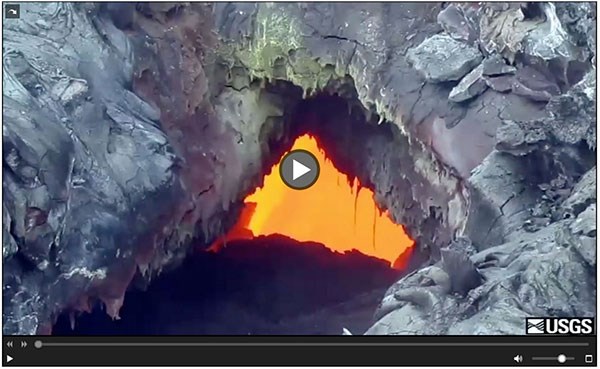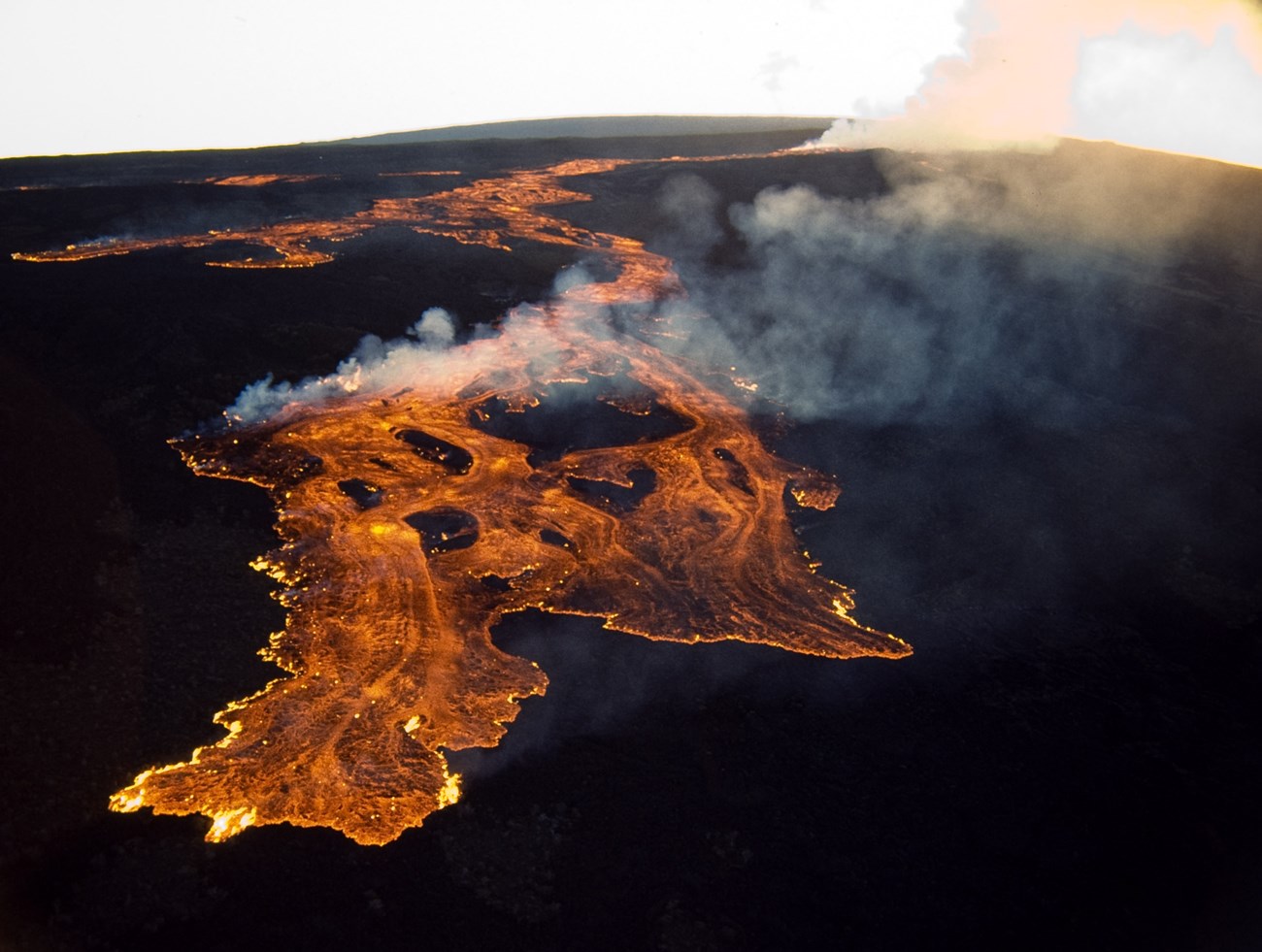
USGS photo.
Introduction
Most lava flows, including the ones from Kīlauea and Mauna Loa volcanoes in Hawai’i Volcanoes National Park, have basaltic compositions. The low silica concentrations in these lavas mean that they are highly fluid (e.g., have low viscosity) and they flow easily, forming lava flows that may travel great distances from the vent where they were erupted to cover broad areas of land.
Basaltic lava flows may be erupted from shield volcanoes such as in Hawai’i, from vents at the base of a cinder cone such as Sunset Crater Volcano National Monument in Arizona, fissure volcanoes such as at Craters of the Moon National Monument in Idaho, and in monogenetic volcanic fields like at El Malpais National Monument in New Mexico.
Basaltic lava flows usually either have pahoehoe or ‘a‘ā morphological forms. The surfaces of pahoehoe lava flows are smooth, ropy, or billowy, and ‘a‘ā flows are rough and clinkery.
Learn More
Basaltic lavas are emitted in effusive (Hawaiian style) eruptions where they either ooze out from vents or are ejected in lava fountains that may be propelled a hundred feet (30 m) or more into the air before landing and starting to flow as molten rock. Lavas that are discharged at high rates generally travel faster and further from their vent than ones that are erupted at lower rates. Topography, especially the steepness of slopes on which lavas flow, also greatly impact the speeds and distances that they can travel.
Basaltic lava flows generally travel as either:
-
broad sheets,
-
in channels,
-
or through lava tubes.
Sheet-fed Lava Flows
Sheet-fed flows do not have any surface channels, and flow as a single body of lava. They generally occur during eruptions with high discharge rates and usually in high volume eruptions. Sheet-fed lava flows also may occur on areas of gentle slopes. Both pāhoehoe and ‘a‘ā lavas may be sheet-fed. Sheet-fed pāhoehoe lava flows may be inflated since the surface crust may be cooled while lava is still being fed into the flow.
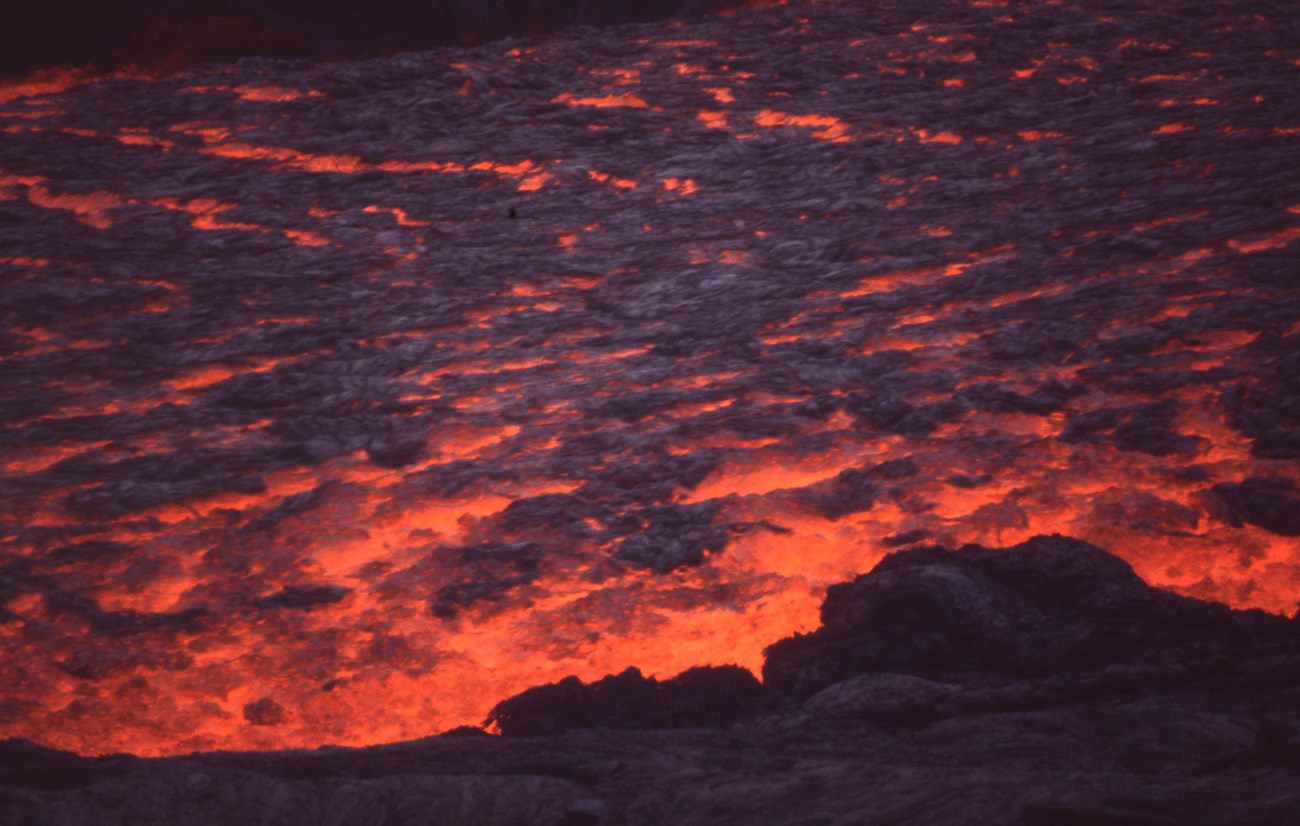
NPS Photo by B. Seiber.
Channel-fed Lava Flows
Some lavas travel primarily in surface channels that develop between levees made of chilled portions of the flow. Levees may be higher than the molten stream of lava when discharge rate decreases from a higher initial rate. And channel levees may be overtopped if the discharge rate increases or if an obstruction in the channel forms downstream. Channels in lava flows sometimes follow preexisting topographic lows like river valleys or form novel ones based on the topography of the chilled flow surface. Both pāhoehoe and ‘a‘ā lavas may flow in channels.
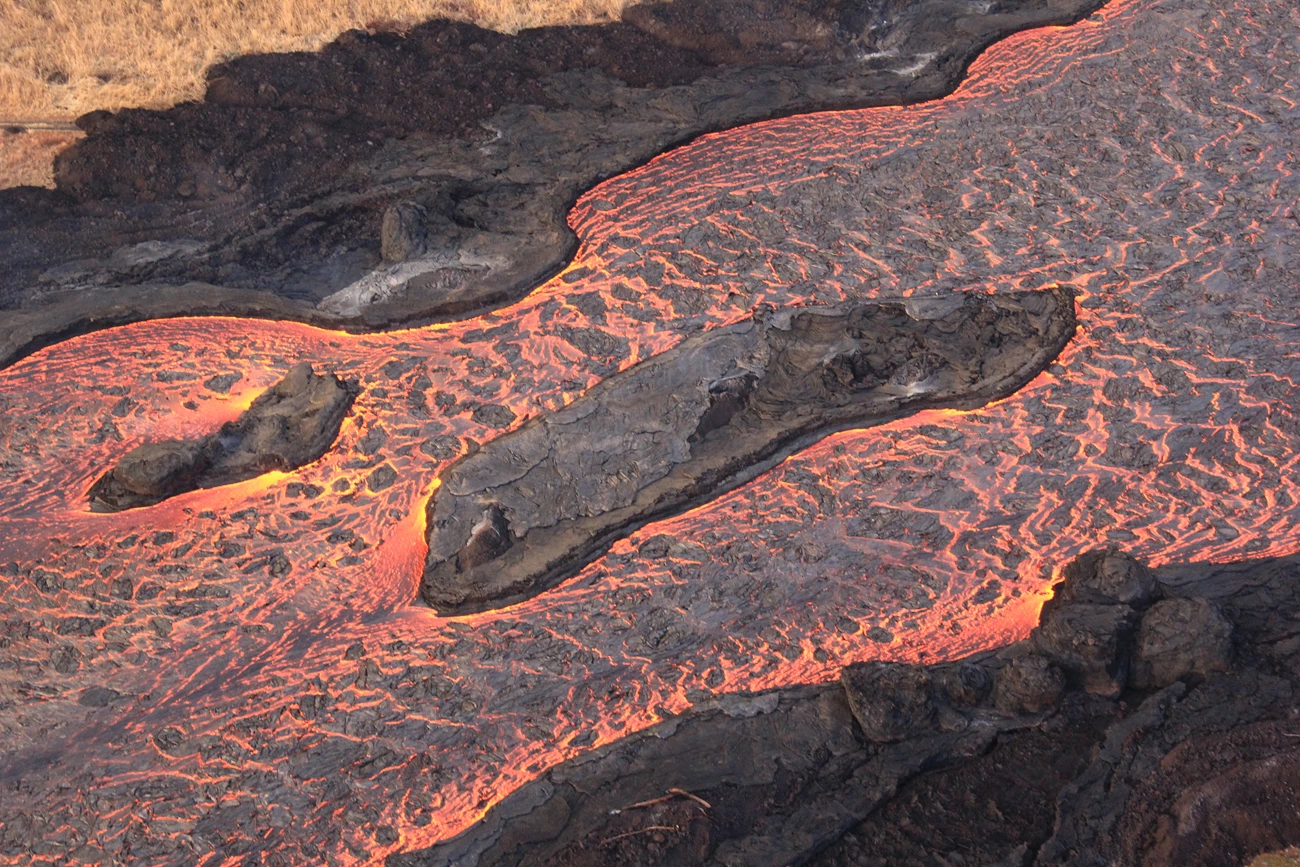
USGS photos.
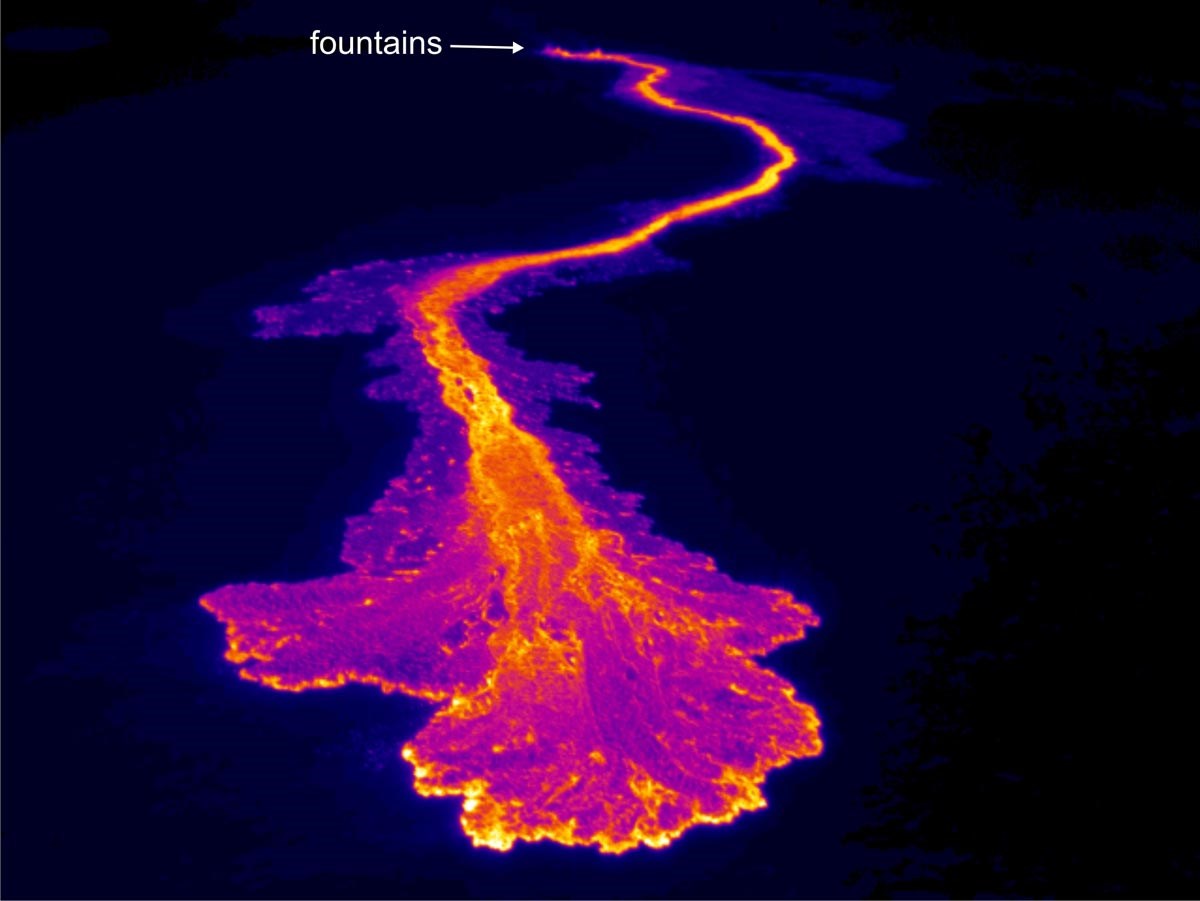
USGS image.
Tube-fed Lava Flows
Lava tubes are conduits in the interior of lava flows through which molten lava travels. A lava tube may form by the crusting over of a surface lava channel or when the chilled surface of a flow insulates channels flowing lava within it. Lava may flow very rapidly inside tubes on steep slopes as it remains very hot and fluid in the interior of a flow. Lava flowing in tubes in Hawai’i Volcanoes National Park can flow as fast as 19 miles (30 km) per hour.
Lava tubes may drain at the end of the eruption or when lava is diverted elsewhere in the flow. Lava tubes may also collapse during the eruption or after it ends.
Some lava tube caves are many miles (kms) long, such as ones in Lava Beds National Monument and El Malpais National Monument.
Lava tubes are usually only found in pāhoehoe flows.
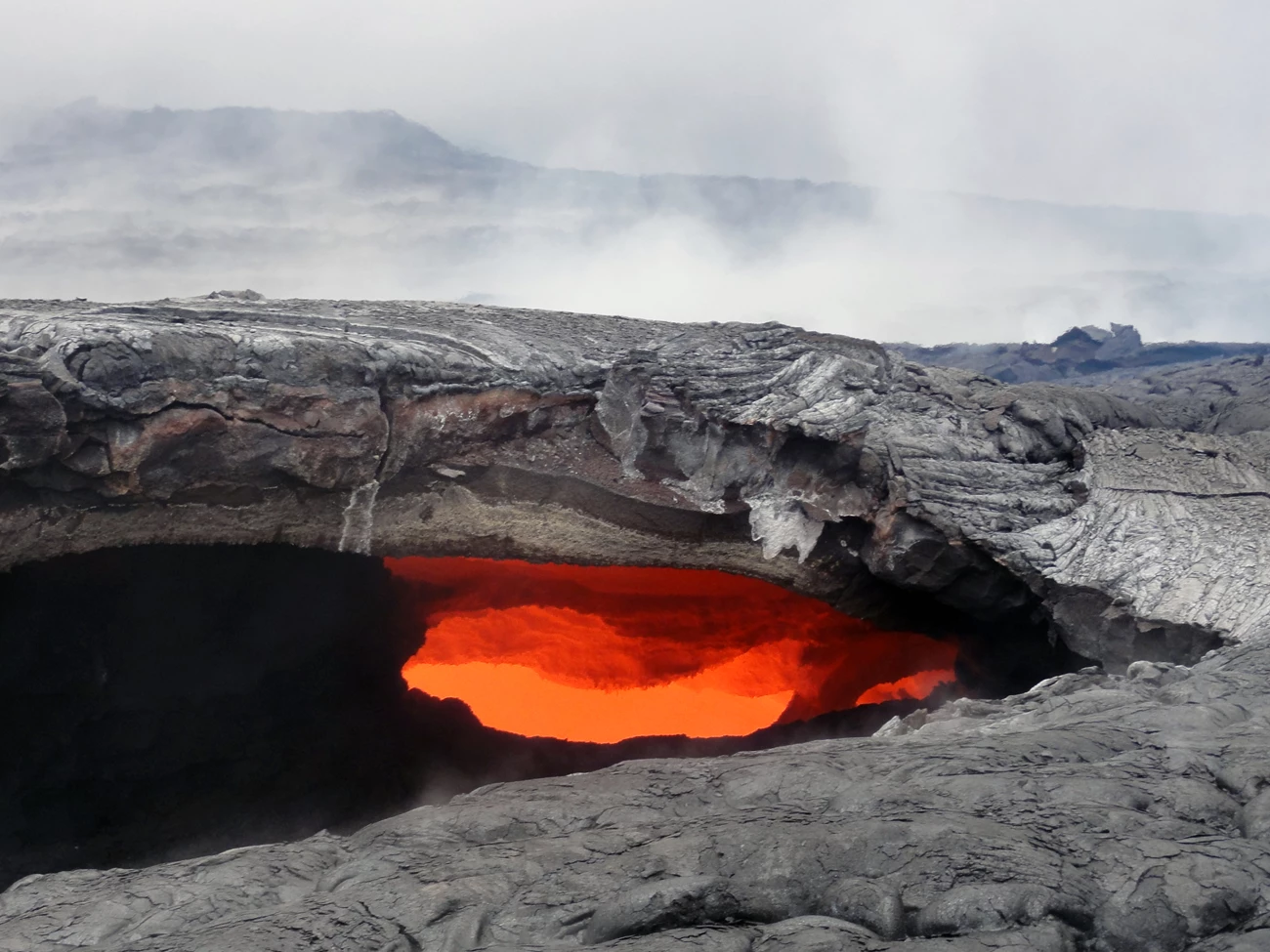
USGS photo.
Featured Video
Basaltic Lava Flow Features
Basaltic lava flows are more than just seas of black rock. Solidified flows have features that provide information about their eruptions and emplacement.
► Breakout
A breakout is a new area or region of a lava flow formed where lava from the molten interior of a previously formed lobe breaks out through its sides or upper margin to create a distinct lava flow advance.
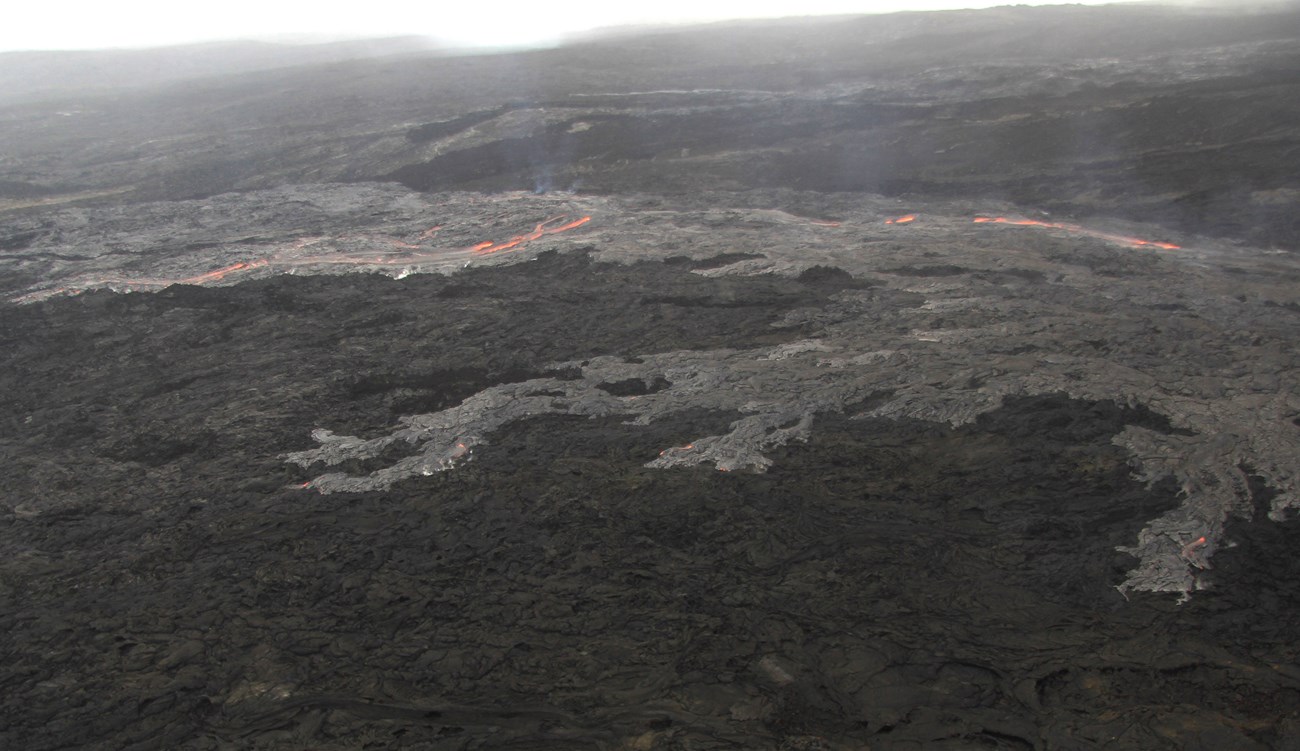
USGS photo.
► Lava Flow Fields
A lava flow field is a body of lava, consisting of one or more lava flows, that is the product of a single eruption.
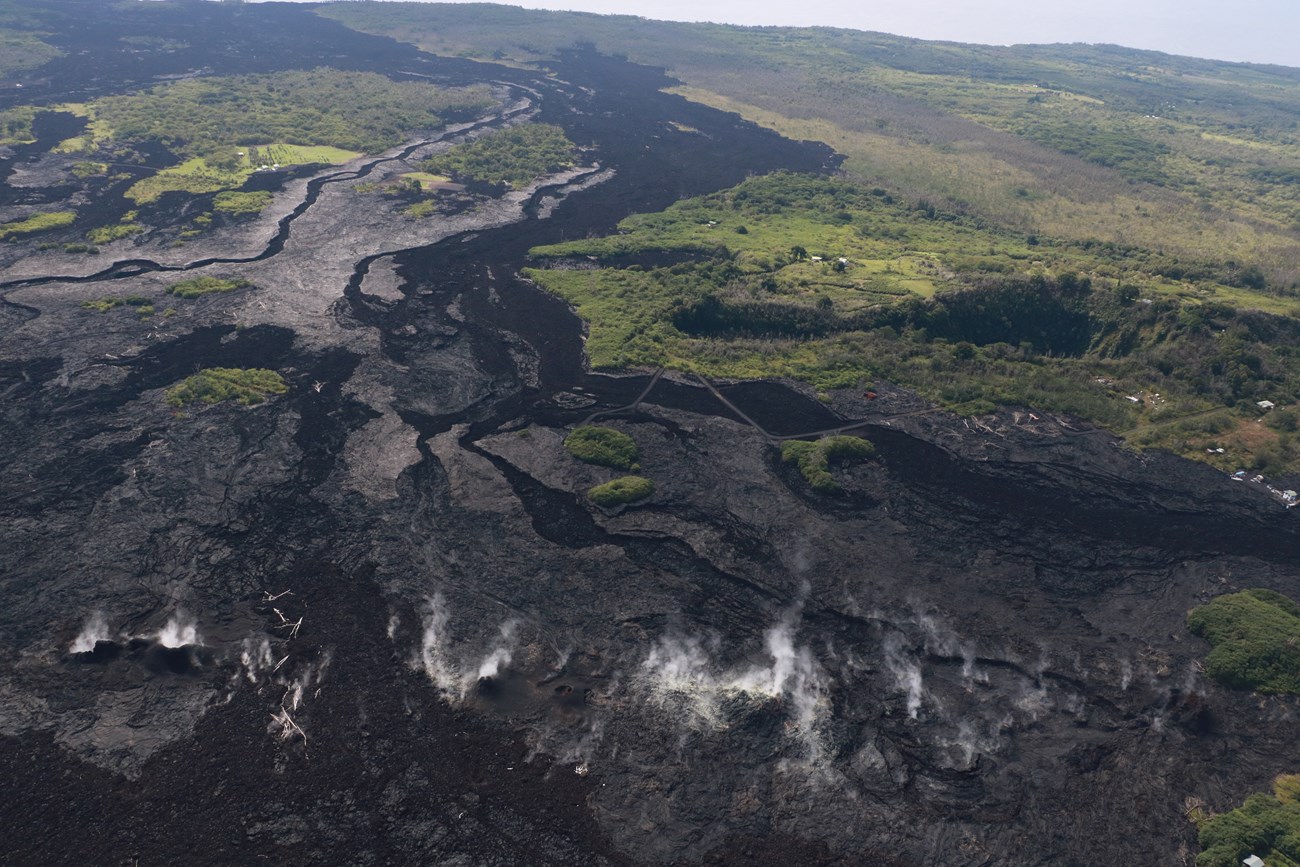
USGS photo by K. Mulliken.
► Surface Features
Basaltic lava flows, particularly pāhoehoe flows, may have a variety of surface features including hornitos, levees, tumuli, pressure ridges, and squeeze-ups.
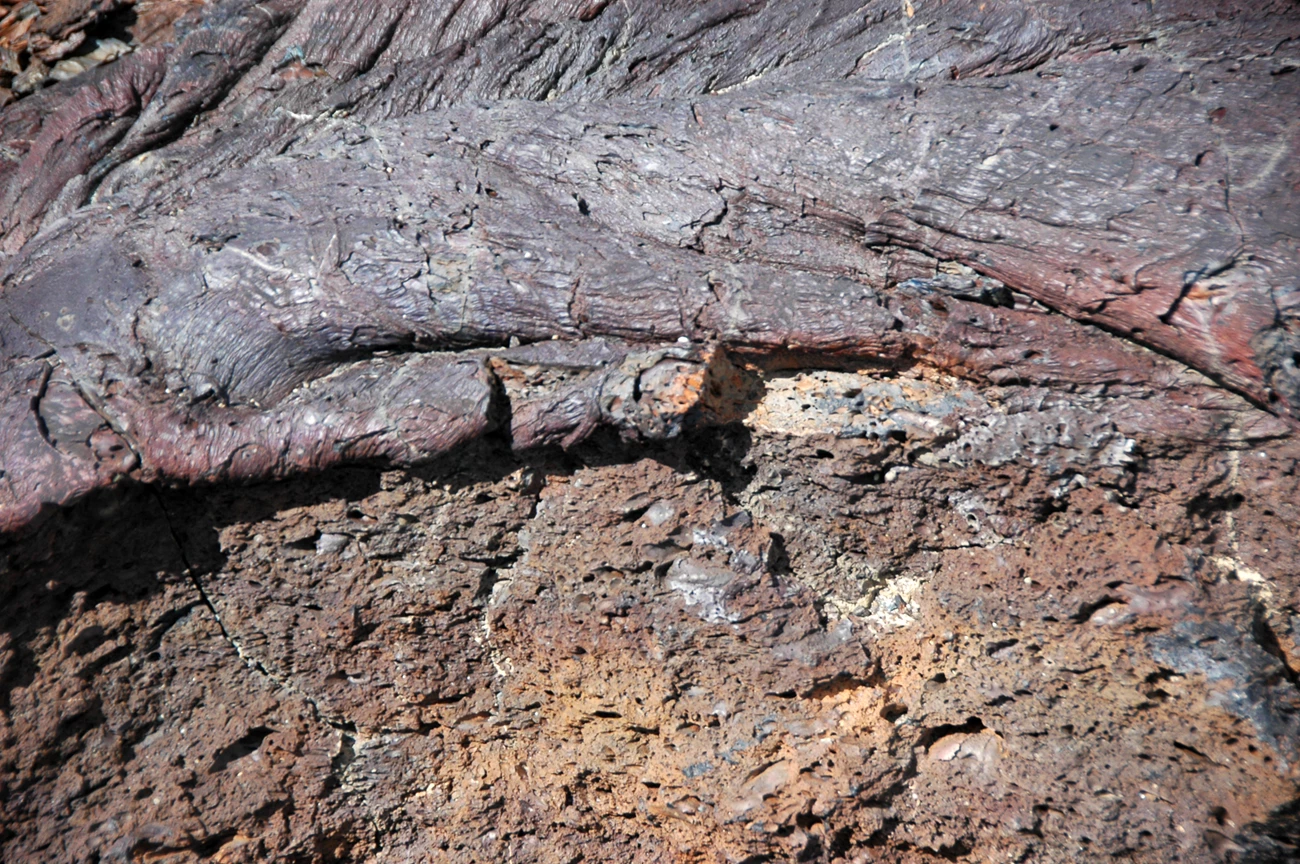
Photo by John St. James on Flickr.
Learn More
► Lava Tubes
Lava tubes or collapsed lava tubes may be present in basaltic lava flows.
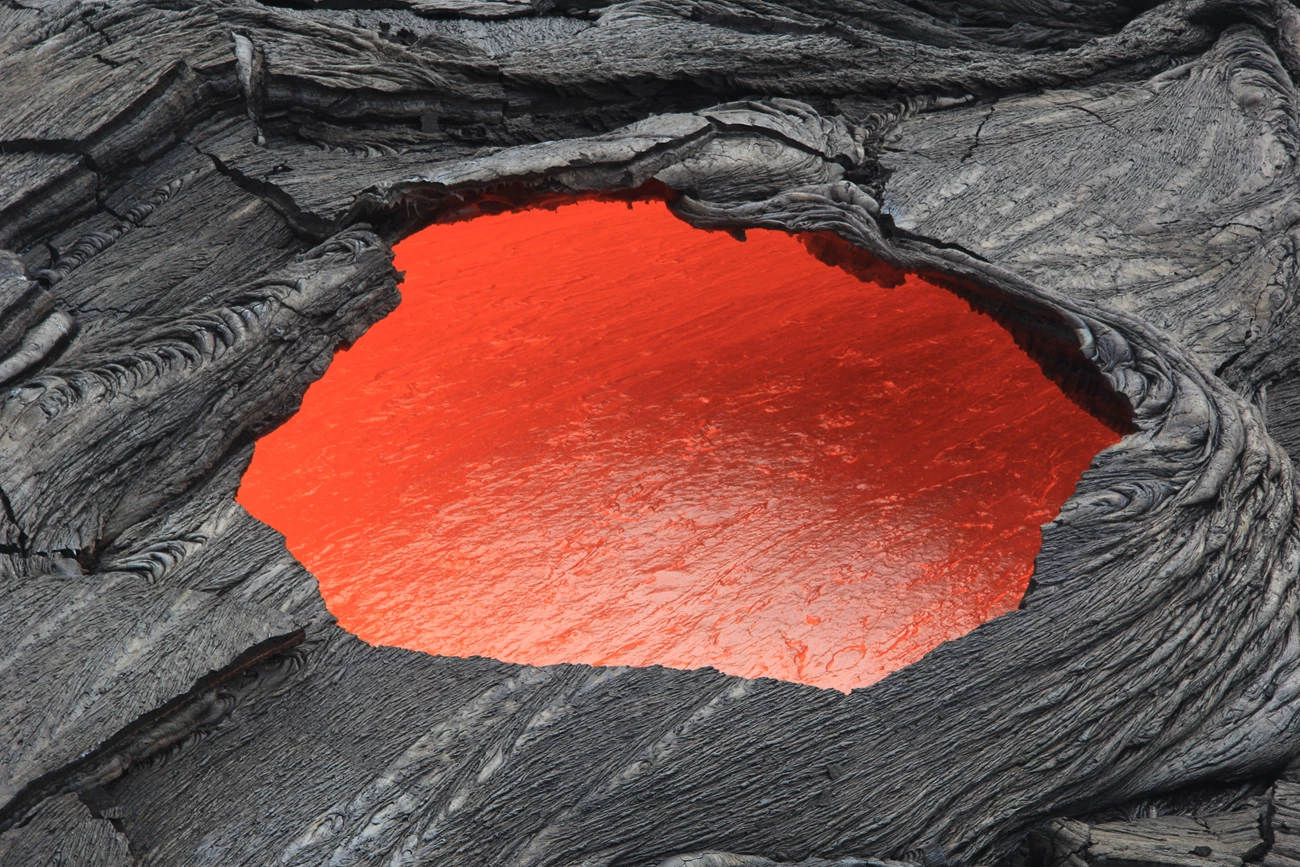
USGS photo.
Learn More
Related Links
► Inflation Structures
Sheet-fed pāhoehoe flows may inflate after their crusts have solidified and their flow front has stopped advancing or cannot move fast enough to accommodate the rate of lava supply. Inflation thickens the lava flows and forms surface features such as tumuli and inflation pits.
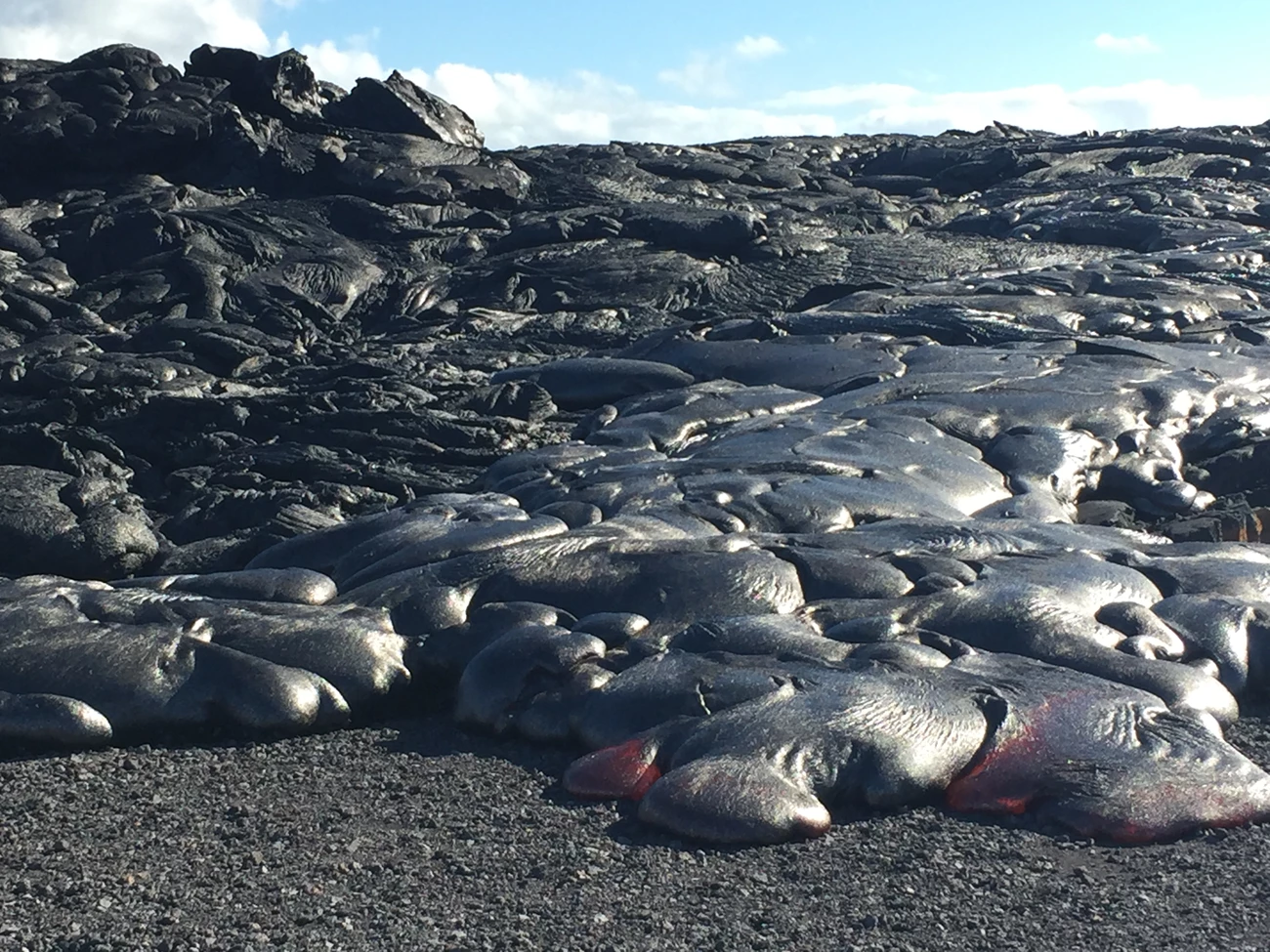
USGS photo.
Learn More
► Tree Mold Fossils
Lava flows may surround either standing or fallen trees, leaving behind tree mold fossils.
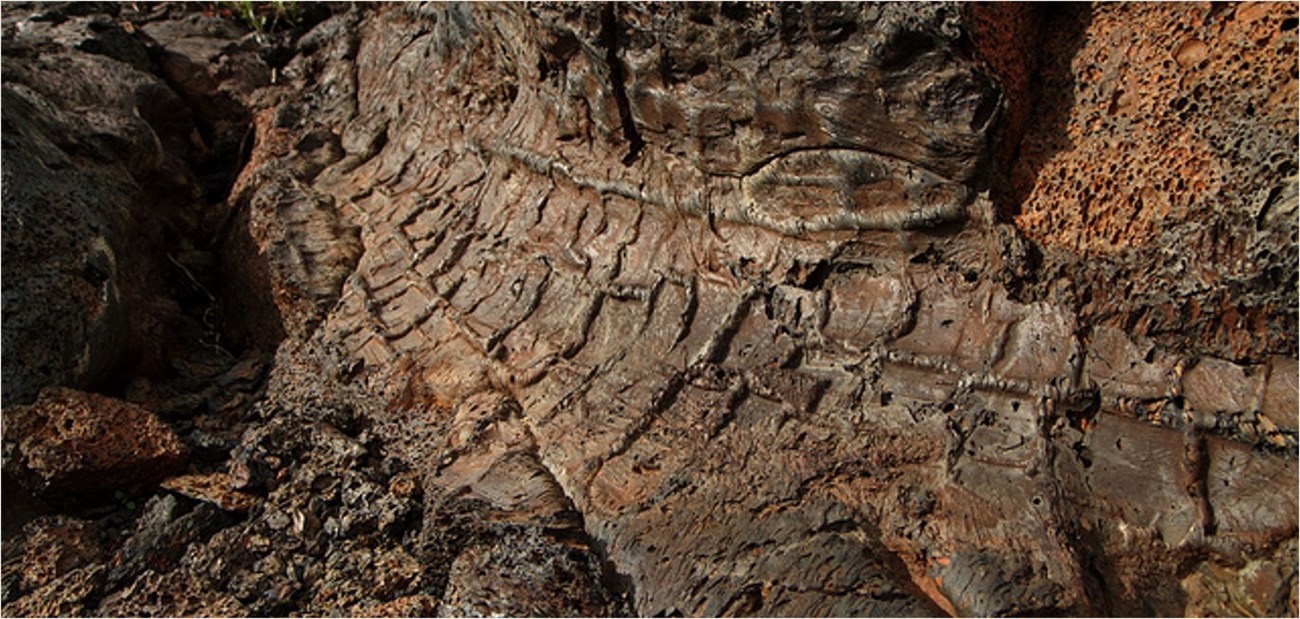
USGS photo.
Learn More
► Kīpukas
Kipukas are areas that are surrounded by lava flows. In areas with young lava flows, they may be islands of vegetation and animal habitat surrounded by relatively inhospitable rock.
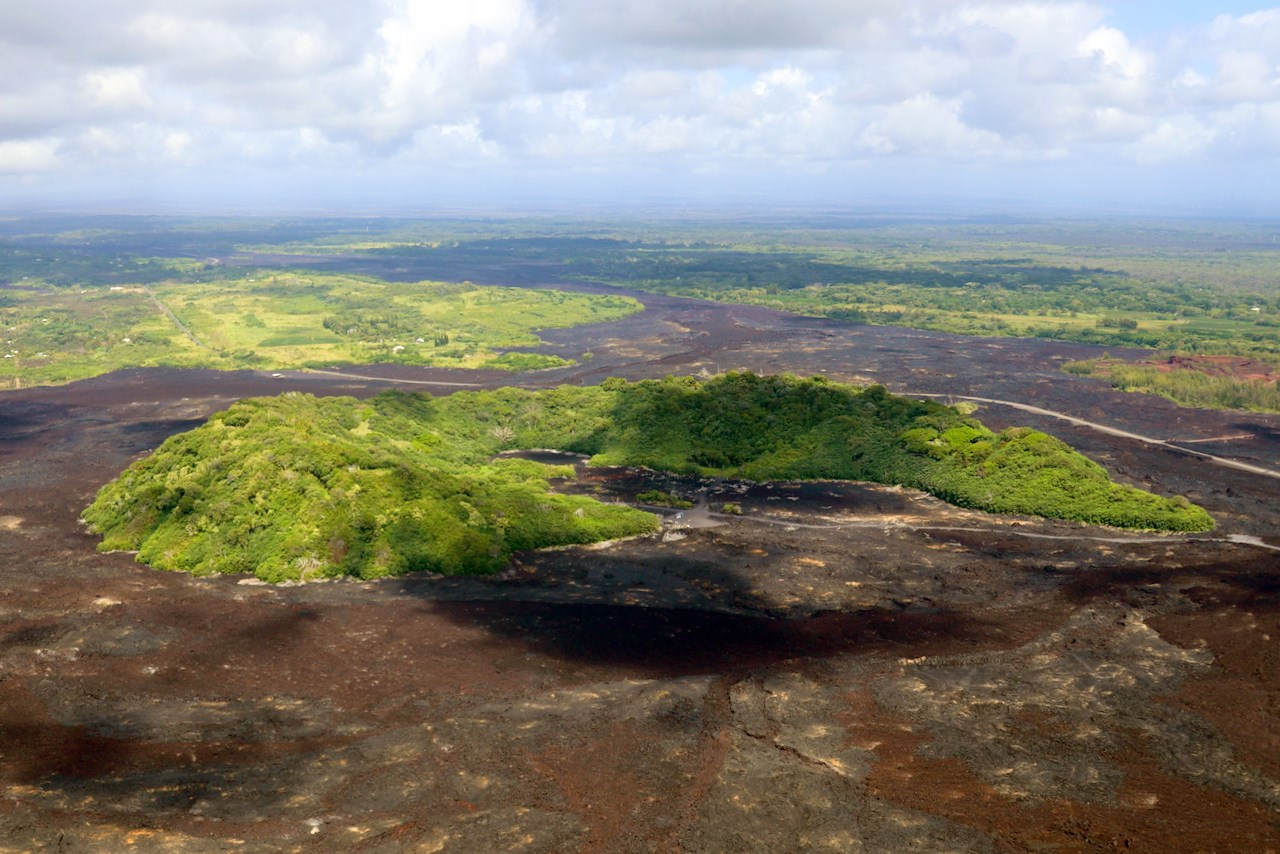
USGS photo by J. Schmith.
Learn More
► Pillow Basalts
Pillow lavas form during subaqueous eruptions when the lava surface is rapidly quenched but the interior continues to inflate as the eruption continues. Most pillow lavas have basaltic compositions.
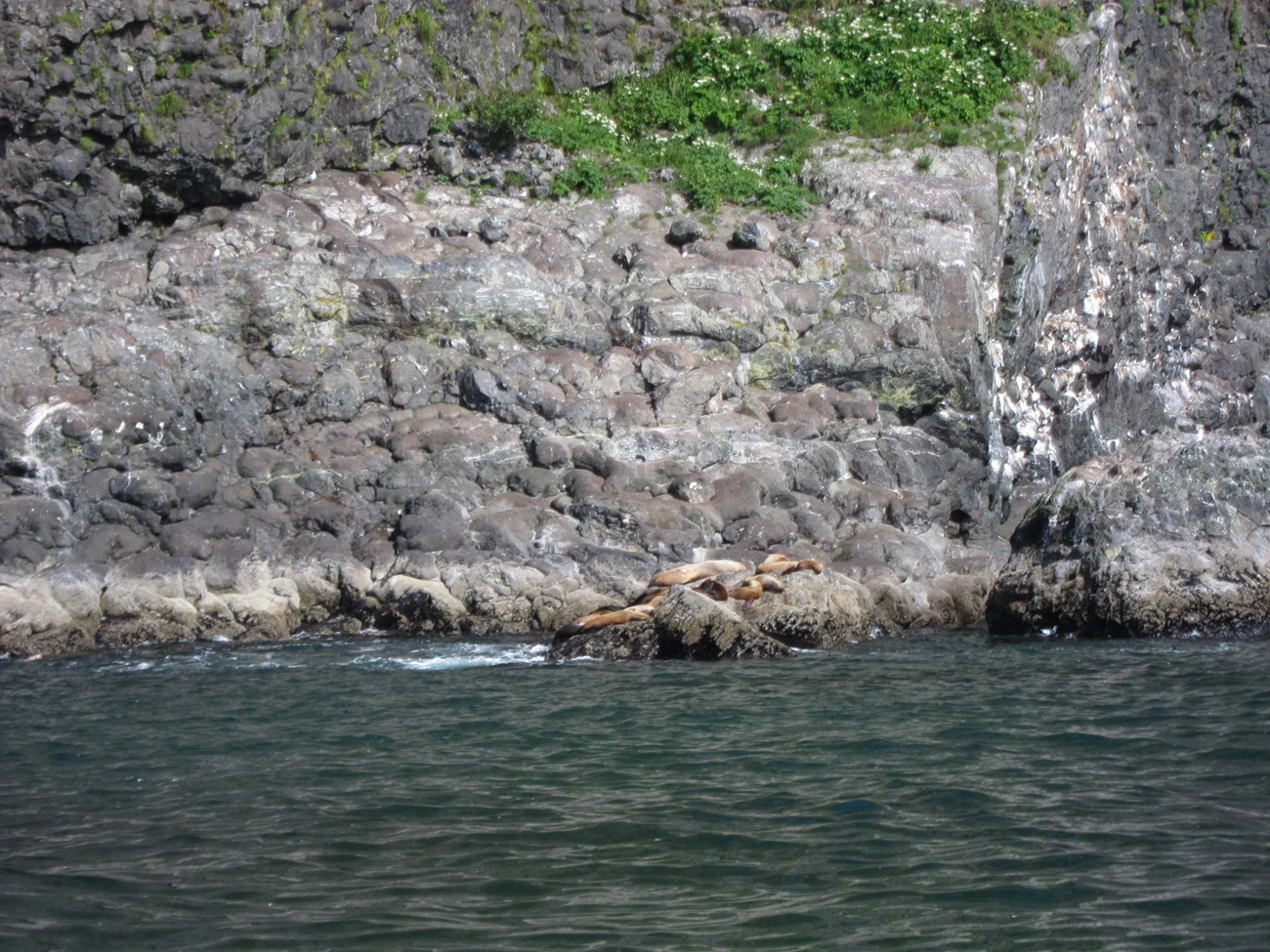
Photo courtesy of Cameron Davidson.
Learn More
Parks with Basaltic Lava Flows
-
Bandelier National Monument (BAND), New Mexico—[BAND Geodiversity Atlas] [BAND Park Home] [BAND npshistory.com]
-
Bering Land Bridge National Preserve (BELA), Alaska—[BELA Geodiversity Atlas] [BELA Park Home] [BELA npshistory.com]
-
Big Bend National Park (BIBE), Texas—[BIBE Geodiversity Atlas] [BIBE Park Home] [BIBE npshistory.com]
-
Capulin Volcano National Monument (CAVO), New Mexico—[CAVO Geodiversity Atlas] [CAVO Park Home ] [CAVO npshistory.com]
-
Crater Lake National Park (CRLA), Oregon—[CRLA Geodiversity Atlas] [CRLA Park Home] [CRLA npshistory.com]
-
Craters of the Moon National Monument (CRMO), Idaho—[CRMO Geodiversity Atlas] [CRMO Park Home] [CRMO npshistory.com]
-
Death Valley National Park (DEVA), California & Nevada—[DEVA Geodiversity Atlas] [DEVA Park Home] [DEVA npshistory.com]
-
Devils Postpile National Monument (DEPO), California—[DEPO Geodiversity Atlas] [DEPO Park Home] [DEPO npshistory.com]
-
El Malpais National Monument (ELMA), New Mexico—[ELMA Geodiversity Atlas] [ELMA Park Home] [ELMA npshistory.com]
-
Fort Vancouver National Historic Site (FOVA), Washington—[FOVA Geodiversity Atlas] [FOVA Park Home] [FOVA npshistory.com]
-
Grand Canyon National Park (GRCA), Arizona—[GRCA Geodiversity Atlas] [GRCA Park Home] [GRCA npshistory.com]
-
Grand Canyon-Parashant National Monument (PARA), Arizona—[PARA Geodiversity Atlas] [PARA Park Home] [PARA npshistory.com]
-
Grand Teton National Park (GRTE), Wyoming—[GRTE Geodiversity Atlas] [GRTE Park Home] [GRTE npshistory.com]
-
Hagerman Fossil Beds National Monument (HAFO), Idaho—[HAFO Geodiversity Atlas] [HAFO Park Home] [HAFO npshistory.com]
-
Haleakala National Park (HALE), Hawaii—[HALE Geodiversity Atlas] [HALE Park Home] [HALE npshistory.com]
-
Hawai’i Volcanoes National Park (HAVO), Hawai’i—[HAVO Geodiversity Atlas] [HAVO Park Home] [HAVO npshistory.com]
-
Isle Royale National Park (ISRO), Michigan—[ISRO Geodiversity Atlas] [ISRO Park Home] [ISRO npshistory.com]
-
Kalaupapa National Historical Park (KALA), Hawai’i—[KALA Geodiversity Atlas] [KALA Park Home] [KALA npshistory.com]
-
Kaloko-Honokohau National Historical Park (KAHO), Hawai'i—[KAHO Geodiversity Atlas] [KAHO Park Home] [KAHO npshistory.com]
-
Katmai National Park (KATM), Alaska—[KATM Geodiversity Atlas] [KATM Park Home] [KATM npshistory.com]
-
Keweenaw National Historic Park (KEWE), Michigan—[KEWE Geodiversity Atlas] [KEWE Park Home] [KEWE npshistory.com]
-
Lake Mead National Recreation Area (LAKE), Arizona and Nevada—[LAKE Geodiversity Atlas] [LAKE Park Home] [LAKE npshistory.com]
-
Lake Roosevelt National Recreation Area (LARO), Washington—[LARO Geodiversity Atlas] [LARO Park Home] [LARO npshistory.com]
-
Lassen Volcanic National Park (LAVO), California—[LAVO Geodiversity Atlas] [LAVO Park Home] [LAVO npshistory.com]
-
Lava Beds National Monument (LABE), California—[LABE Geodiversity Atlas] [LABE Park Home] [LABE npshistory.com]
-
Lewis and Clark National Historical Park (LEWI), Oregon and Washington—[Volcanoes of the Lewis & Clark Trail]
-
Mojave National Preserve (MOJA), California—[MOJA Geodiversity Atlas] [MOJA Park Home] [MOJA npshistory.com]
-
National Park of American Samoa (NPSA), American Samoa—[NPSA Geodiversity Atlas] [NPSA Park Home] [NPSA npshistory.com]
-
Petrified Forest National Park (PEFO), Arizona—[PEFO Geodiversity Atlas] [PEFO Park Home] [PEFO npshistory.com]
-
Petroglyph National Monument (PETR), New Mexico—[PETR Geodiversity Atlas] [PETR Park Home] [PETR npshistory.com]
-
Pu'uhonau o Honaunau National Historic Park (PUHO), Hawai'i—[PUHO Geodiversity Atlas] [PUHO Park Home] [PUHO npshistory.com]
-
Pu'ukohola Heiau National Historic Site (PUHE), Hawai'i—[PUHE Geodiversity Atlas] [PUHE Park Home] [PUHE npshistory.com]
-
Rocky Mountain National Park (ROMO), Colorado—[ROMO Geodiversity Atlas] [ROMO Park Home] [ROMO npshistory.com]
-
Shenandoah National Park (SHEN), Virginia—[SHEN Geodiversity Atlas] [SHEN Park Home] [SHEN npshistory.com]
-
Sunset Crater Volcano National Monument (SUCR), Arizona—[SUCR Geodiversity Atlas] [SUCR Park Home] [SUCR npshistory.com]
-
Voyageurs National Park (VOYA), Minnesota—[VOYA Geodiversity Atlas] [VOYA Park Home] [VOYA npshistory.com]
-
Wupatki National Monument (WUPA), Arizona—[WUPA Geodiversity Atlas] [WUPA Park Home] [WUPA npshistory.com]
-
Yellowstone National Park (YELL), Wyoming—[YELL Geodiversity Atlas] [YELL Park Home] [YELL npshistory.com]
-
Yosemite National Park (YOSE), California—[YOSE Geodiversity Atlas] [YOSE Park Home] [YOSE npshistory.com]
-
Zion National Park (ZION), Utah—[ZION Geodiversity Atlas] [ZION Park Home] [ZION npshistory.com]
Last updated: April 18, 2023

